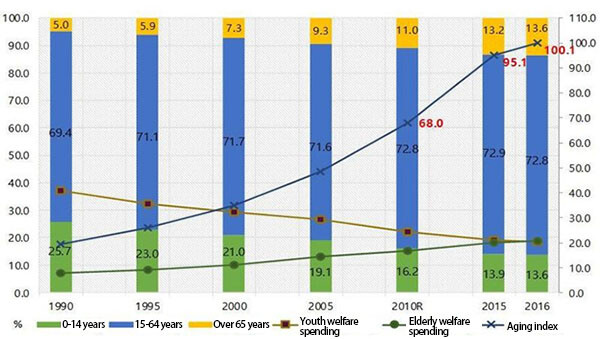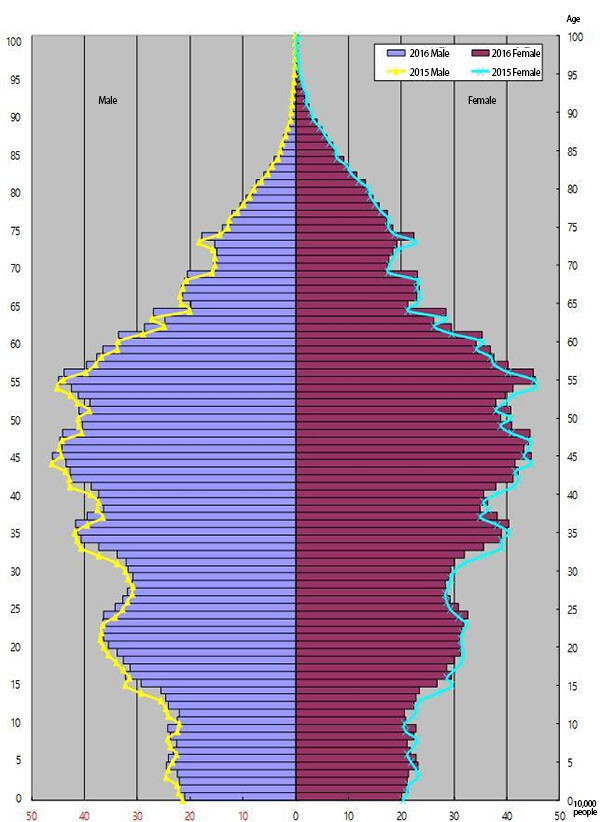hankyoreh
Links to other country sites 다른 나라 사이트 링크
South Korean population aging faster than expected

South Korea’s elderly population outnumbered children 14 and under for the first time ever last year, statistics show. The reversal, which came one year ahead of predictions, shows that the time frame for South Korea’s aging trend is accelerating.
Figures announced by Statistics Korea on Aug. 21 from the 2016 population and housing census showed South Korea’s total population at 51,270,000 as of Nov. 2016, an increase of 200,000 (0.4%) from 2015. The number included 6,775,000 seniors aged 65 and over, or 7,000 more than the 6,768,000 children 14 and under.
The 2016 numbers marked the first time that the elderly have outnumbered children. The number of seniors was up by 206,000 from the year before (3.1%), while the number of children dropped by 138,000 (-2.0%). The change translated into a drop from 22.2 to 19.1 in the dependency ratio for children and an increase from 15.1 to 18.1 in the dependency ratio for seniors. The dependency ratio is the population of children or seniors divided by the 36.31 million people in the productive population aged 15 to 64.

Future population trend predictions issued by Statistics Korea last year forecast that seniors would outnumber children as of 2017. With the number of births falling below expectations last year, the reversal came one year ahead of schedule.
“The timeline for the change in population structure moved up as the birth rate dropped below population trend predictions, which had been based on 2015 figures,” explained a Statistics Korea source.
Actual births last year were 7,000 fewer than predicted in the future population trends. While South Korea had previously been predicted to become an aging society (14% or more senior citizens) by 2018 and a super-aging society (20% or more) by 2016, that time frame is also likely to be accelerated.
By region, the senior citizen population in South Gyeongsang Province rose from 13.9% to 14.3% last year, marking its entrance into aging society status. Currently, South Jeolla is the only one of South Korea’s 17 metropolitan cities and provinces considered a super-aging society (21.3%).
Among the 19,840,000 households counted last year, the number consisting solely of seniors stood at 2,260,000 (11.6%), up 110,000 from the year before. More than half of them – 1,290,000, or 6.7% of all households – consisted of seniors living on their own. The number was up by 70,000 from the year before and accounted for 24% of all single-person households.
By Heo Seung, staff reporter
Please direct questions or comments to [english@hani.co.kr]

Editorial・opinion
![[Column] Has Korea, too, crossed the Rubicon on China? [Column] Has Korea, too, crossed the Rubicon on China?](https://flexible.img.hani.co.kr/flexible/normal/500/300/imgdb/original/2024/0419/9317135153409185.jpg) [Column] Has Korea, too, crossed the Rubicon on China?
[Column] Has Korea, too, crossed the Rubicon on China?![[Correspondent’s column] In Japan’s alliance with US, echoes of its past alliances with UK [Correspondent’s column] In Japan’s alliance with US, echoes of its past alliances with UK](https://flexible.img.hani.co.kr/flexible/normal/500/300/imgdb/original/2024/0419/2317135166563519.jpg) [Correspondent’s column] In Japan’s alliance with US, echoes of its past alliances with UK
[Correspondent’s column] In Japan’s alliance with US, echoes of its past alliances with UK- [Editorial] Does Yoon think the Korean public is wrong?
- [Editorial] As it bolsters its alliance with US, Japan must be accountable for past
- [Guest essay] Amending the Constitution is Yoon’s key to leaving office in public’s good graces
- [Editorial] 10 years on, lessons of Sewol tragedy must never be forgotten
- [Column] A death blow to Korea’s prosecutor politics
- [Correspondent’s column] The US and the end of Japanese pacifism
- [Guest essay] How Korea turned its trainee doctors into monsters
- [Guest essay] As someone who helped forge Seoul-Moscow ties, their status today troubles me
Most viewed articles
- 1[Column] The clock is ticking for Korea’s first lady
- 2After 2 months of delayed, denied medical care, Koreans worry worst may be yet to come
- 3US overtakes China as Korea’s top export market, prompting trade sanction jitters
- 4[Column] Has Korea, too, crossed the Rubicon on China?
- 5[Correspondent’s column] In Japan’s alliance with US, echoes of its past alliances with UK
- 6Hong Se-hwa, voice for tolerance whose memoir of exile touched a chord, dies at 76
- 7[Editorial] When the choice is kids or career, Korea will never overcome birth rate woes
- 8Samsung barricades office as unionized workers strike for better conditions
- 9All eyes on Xiaomi after it pulls off EV that Apple couldn’t
- 10More South Koreans, particularly the young, are leaving their religions